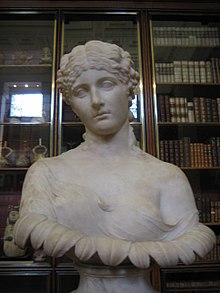Our website is made possible by displaying online advertisements to our visitors.
Please consider supporting us by disabling your ad blocker.
Clytie (Oceanid)
| Clytie | |
|---|---|
| Member of the Oceanids | |
 Townley's Clytie | |
| Other names | Clytia |
| Greek | Κλυτίη |
| Abode | Boeotia, others |
| Symbols | Heliotropium |
| Genealogy | |
| Parents | Oceanus and Tethys or Orchomenus/Orchamus |
| Siblings | The Oceanids, the Potamoi or Leucothoe |
| Consort | Helios |
Clytie (/ˈklaɪtiiː/; Ancient Greek: Κλυτίη, romanized: Klutíē) or Clytia (/ˈklaɪtiə/; Ancient Greek: Κλυτία, romanized: Klutía, lit. 'renowned') is a water nymph, daughter of the Titans Oceanus and Tethys in Greek mythology. She is thus one of the 3,000 Oceanid nymphs, and sister to the 3,000 Potamoi (the river-gods).
According to the myth, Clytie loved the sun-god Helios in vain, but he left her for another woman, the princess Leucothoe, under the influence of Aphrodite, the goddess of love. In anger and bitterness, she revealed their affair to the girl's father, indirectly causing her doom as the king buried her alive. This failed to win Helios back to her, and she was left lovingly staring at him from the ground; eventually she turned into a heliotrope, a violet flower that gazes at the Sun each day in its diurnal journey.
Clytie's story is mostly known from and fully preserved in Ovid's narrative poem Metamorphoses, though other brief accounts and references to her from other authors survive as well.
Previous Page Next Page


